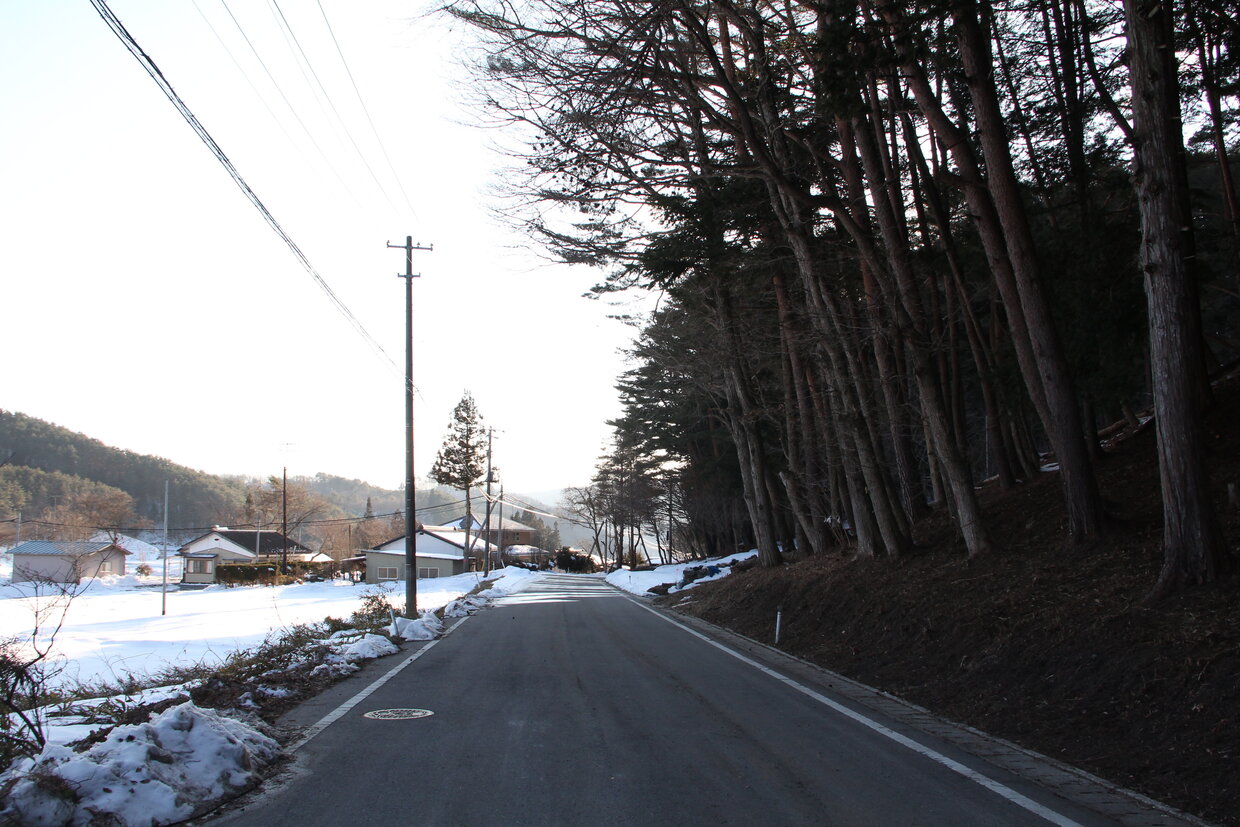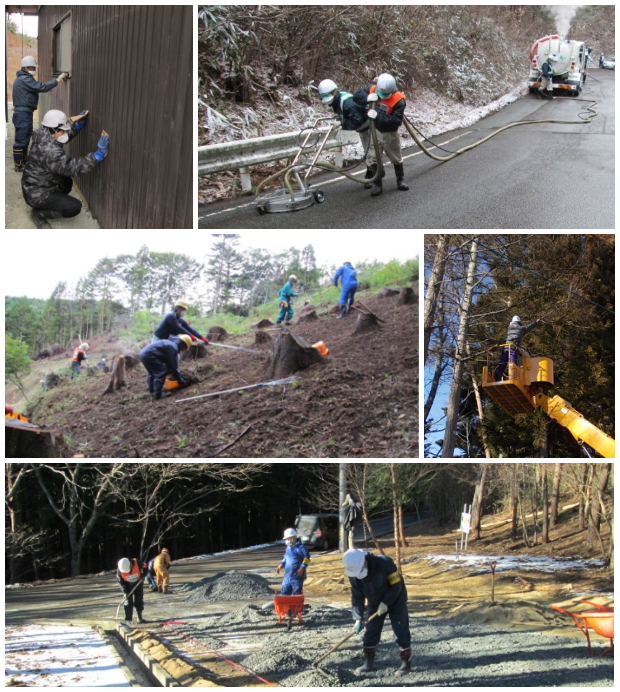Marking Obayashi Corporation's 120th Anniversary with a New Vision for the Future
Establishment of the Obayashi Basic Principles
Since its founding in 1892, Obayashi Corporation has built technology and integrity into its DNA and continued to provide high-quality construction services that earn the trust of its customers. On its 120th anniversary in January 2011, the company established and unveiled the Obayashi Basic Principles and corporate messages, aiming to pass on its DNA and become a leading sustainable company.
The Obayashi Basic Principles consist of “VISION: Who We Want to Be,” “SOCIAL RESPONSIBILITY: Our Unique Approach,” “ACTION COMMITMENTS: How We Do Things,” and “VALUES: What We Believe In.”
Obayashi Basic Principles
VISION: Who We Want to Be
A Leading Sustainable Company
- Exercise honest craftsmanship with superior technologies and create new value in every space.
- Care for the global environment and create solutions to social challenges as a good corporate citizen.
- Value each person with a stake in our business.
By keeping these promises, Obayashi Corporation contributes to realizing a sustainable society.
SOCIAL RESPONSIBILITY: Our Unique Approach
At Obayashi, we think of fulfilling our corporate responsibility as the best way to bring smiles to people. This is the goal of all of our business activities. As a good corporate citizen, Obayashi strives to meet the expectations and respond to the needs of all stakeholders. The word for “smiles” in Japanese is egao. We use the four letters of this word to remind us of our responsibilities to society.
Engagement with customers
Our goal is to be the best partner for every customer. To accomplish this, we continually strive to develop state-of-the-art technology, to provide high-quality buildings and structures that fully satisfy customers, and to deliver solutions for customers’ challenges.
Global perspective
We offer solutions to environmental and social challenges and actively engage in social contribution activities to help build a sustainable world.
Amenity and associates
We create amenable work environments where every one of our associates can work safely and with peace of mind while realizing his or her full potential. We also strive to build trust with all business partners to ensure mutual success.
Open communication with stakeholders
We work hard to maintain our reputation as a trustworthy company by pursuing management transparency, communicating broadly with stakeholders, and constantly enhancing our information disclosure.
Obayashi Corporation has positioned these principles as the backbone shared by all employees to ensure that each one of them carries out their daily work with a full understanding of the meaning and concepts embodied in the principles. In doing so, they will contribute to the realization of a sustainable society and help enhance the company’s corporate value.
The company also selected two concise and memorable corporate messages from over 3,000 in-house entries received: “Toward a Brighter Future”and “Shaping the Times with Care.”
The Obayashi Basic Principles were revised in 2015, at the time when the Financial Services Agency and the Tokyo Stock Exchange established Japan’s Corporate Governance Code. The revised Obayashi Basic Principles are comprised of three layers: at the base is the Obayashi Three Pledges of “Quality, Value, and Efficiency,” the spirit that has guided the company since its founding; the Obayashi Code of Conduct (a restructuring of “Our Unique Approach” to corporate social responsibility and “How We Do Things”) is in the middle; and the Obayashi Philosophy (Who We Want to Be) is at the top (for details, see here).
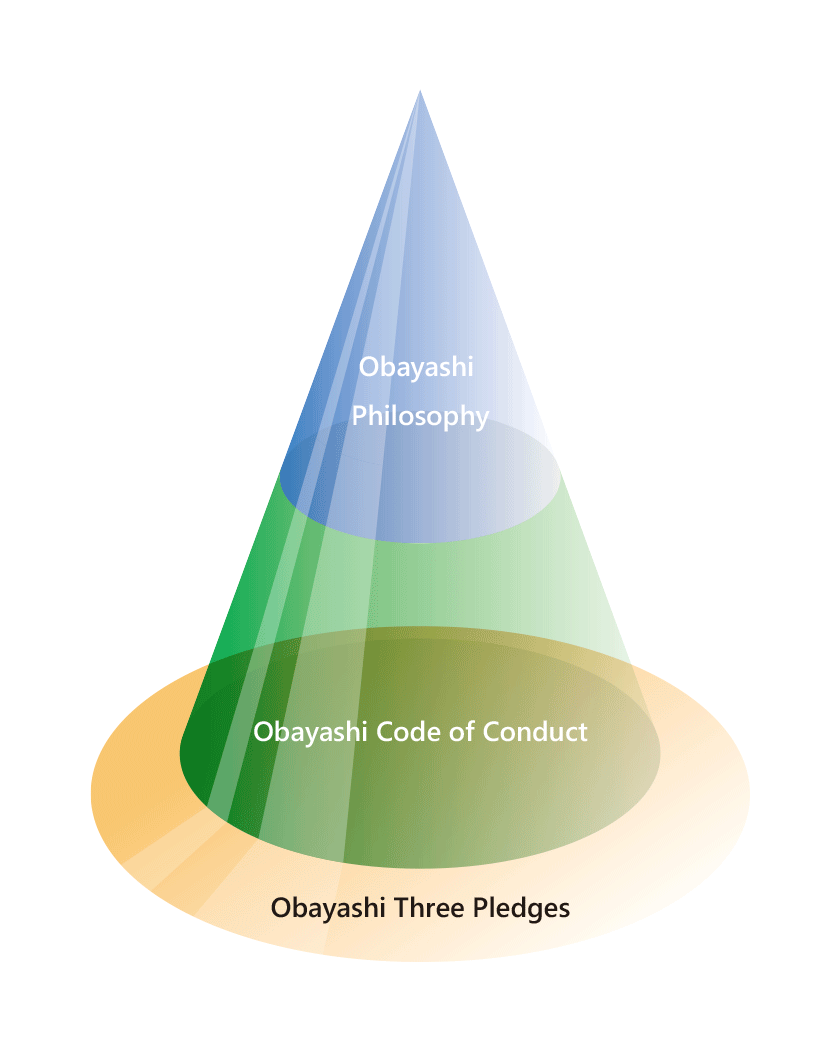
Completion of TOKYO SKYTREE®
TOKYO SKYTREE® was completed in February 2012. Construction work on the tower began in July 2008 and was carried out over three years and eight months. At 634 meters, the Tokyo landmark is the tallest free-standing broadcasting tower in the world. The tower encompasses a culmination of the company’s construction technologies, from knuckle walls to hybrid underground construction method, lift-up construction method, and slipform construction method. The TOKYO SKYTREE® project was completed on schedule despite Tokyo being heavily affected by the Tohoku earthquake and tsunami the year prior, which garnered widespread public attention and turned the impressive building into a new icon of Tokyo.
Sustainability Company: Obayashi Corporation’s Commitment to the Planet, People, and Livelihoods
The Obayashi Basic Principles presented the company’s vision to become “a leading sustainability company.” The word “sustainability” expresses the company’s commitment to providing safety, security, and comfort on the planet and to all people on earth. Moreover, the vision encapsulates its determination to become a leading company that contributes to the creation of a sustainable society through its projects, which are closely intertwined with people and the environment.
The principles outlined three promises toward Obayashi becoming a leading sustainability company. The specific objectives and the company’s intentions embedded in each are as follows.
1. Exercise honest craftsmanship with superior technologies and create new value in every space.
Superior technological ability is at the core of solving social challenges and pioneering the next generation. The company will continue to focus on the succession of technologies and development of advanced technologies, and will seek out the best solutions in response to diverse needs by adhering to a customer-centered approach. The company has, since its founding, earned the deep trust of society through sincere and honest construction work. This is the starting point of the company. It is what the Obayashi brand stands for and forms the DNA passed down continuously through generations. The company’s work is to “create new value in every space” by building new buildings and structures and developing software to make effective use of those constructions. This is Obayashi’s raison d’être.
2. Care for the global environment and create solutions to social challenges as a good corporate citizen.
The construction industry is a core industry that is closely linked to society. In all its business activities, the company has a responsibility to protect the environment in cooperation with its customers and partners and to leave the global environment for future generations in a sustainable manner. As a company that strives for sound and transparent corporate management, takes sensible actions with a high sense of ethics, and is trusted by the broader society, the company will aim for harmony with the community and society and for the development of construction culture, together with creating solutions to social challenges.
3. Value each person with a stake in our business.
The company will generate further momentum in its corporate activities by valuing each person with a stake in its business activities, including its employees, customers, and partner companies. In addition, the company will employ diverse human resources and create a work environment where each employee can demonstrate their unique character and talents to the fullest and work with a sense of pride.
Obayashi Corporation has made sincere efforts to fulfill each of these promises toward realizing a sustainable society and continues to contribute to society as a value-creating company.
Establishment of the Obayashi Green Vision 2050 and Realization of ZEB
Striving continuously to reduce its environmental impact, the company has implemented strategies including reducing carbon dioxide emissions and recycling construction waste. In order to achieve the goal to “contribute to realizing a sustainable society” in the Principles, however, it needed to develop these activities further and engage in them systematically. Accordingly, in February 2011, the company formulated the Obayashi Green Vision 2050, a medium- to long-term environmental vision to work on solving global environmental issues in the course of business activities. It presented a vision for society in 2050, as shown below, and action plans to guide activities and quantitative goals for reducing carbon dioxide emissions were formulated using the backcasting method.
Obayashi Corporation’s Vision for Society in 2050
- Low carbon: A society that stabilizes greenhouse gas concentration at a level that does not cause climate change
- Recycling-oriented: A society that minimizes further extraction of natural resources and creates superior recycling systems
- Respect for the natural world: A society that respects the natural world and conserves biodiversity to preserve the gifts of nature for the future
Shortly after the company announced the Obayashi Green Vision 2050, the Great East Japan Earthquake struck, drastically changing the social environment in Japan. Responding to the changing circumstances, the company established the Environment Department in April 2012, and the environment-related operations of the CSR Department were transferred to the department to enhance efforts for resolving environmental issues. In addition, discussions were held with external experts to ensure steady progress was being made toward the Vision. These efforts culminated in a proposal in 2015 entitled “Future Vision for the Environment.” The targets for carbon dioxide emissions reduction were also revised.
Future Vision for the Environment (Summary)
(1) 3+1 Society
We will aim to achieve our vision for society in 2050, which is what we call a “3+1 Society,” adding “a safe and secure society,” which received renewed attention in the wake of the Great East Japan Earthquake, to the existing three aspects of “a low-carbon society,” “a recycling-oriented society,” and “a society that respects the natural world.”
(2) Integrated approach
We will seek solutions to issues by integrating and coordinating “low-carbon,” “recycling,” “respect for the natural world,” and “safe and secure” to produce synergistic effects, rather than considering them as separate elements. In addition, we aim to be involved in the entire lifecycle of buildings and infrastructure, not only at the construction stage, but also at the upstream stage, including planning, down to the downstream stage, including post-construction lifecycle management and operation.
(3) Promoting partnerships
In our initiatives to realize our vision for society in 2050, we will examine opportunities for collaboration with other companies, governments, and research institutes.
Among the action plans developed by the company, the Net Zero Energy Building (ZEB) action plan achieved low carbon by way of its energy-saving design. ZEB reduces the annual energy balance of a building to zero through the introduction of a variety of energy-saving elemental technologies. The main building of Obayashi Corporation’s Technology Research Institute, the Techno-Station, completed in 2010, achieved source ZEB (where multi-source energy (natural gas, electricity, or oil, etc.) is converted to primary energy ) in FY2015.3, contributing to the reduction of carbon dioxide emissions.
(Reference: Special Contents > Obayashi Technology Research Institute)
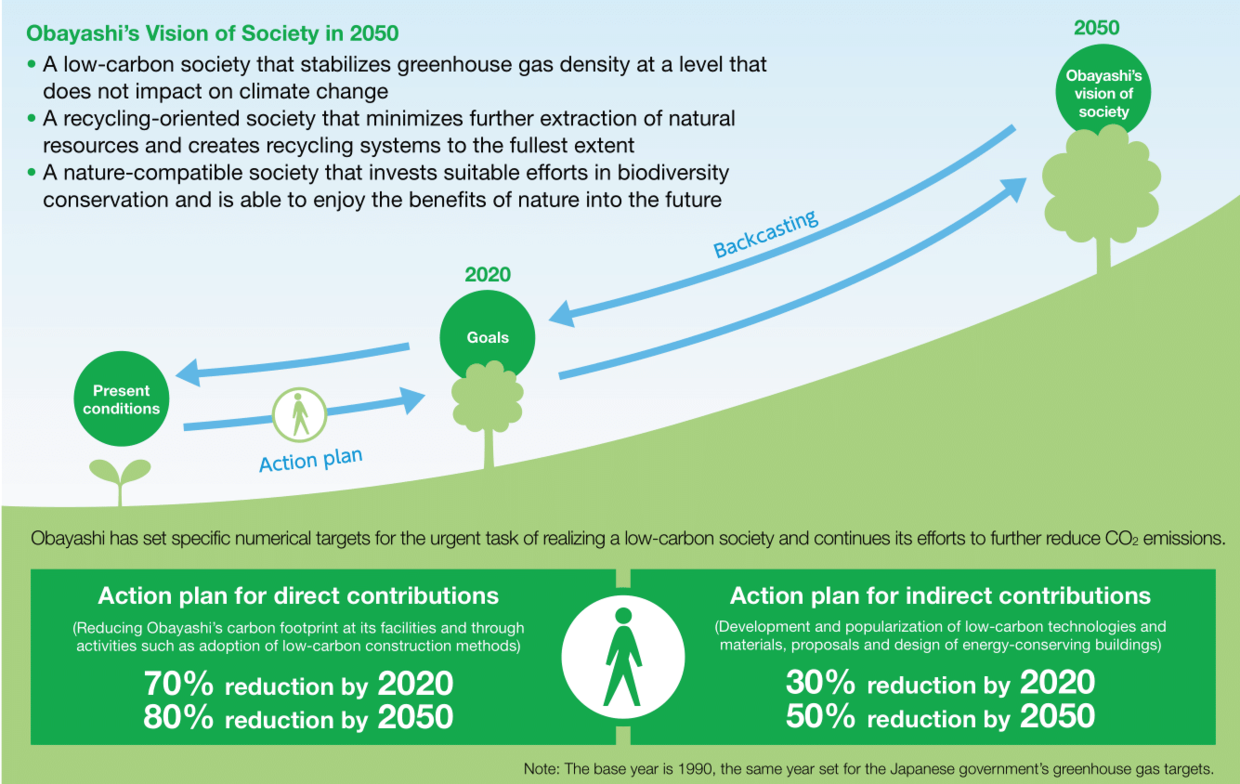
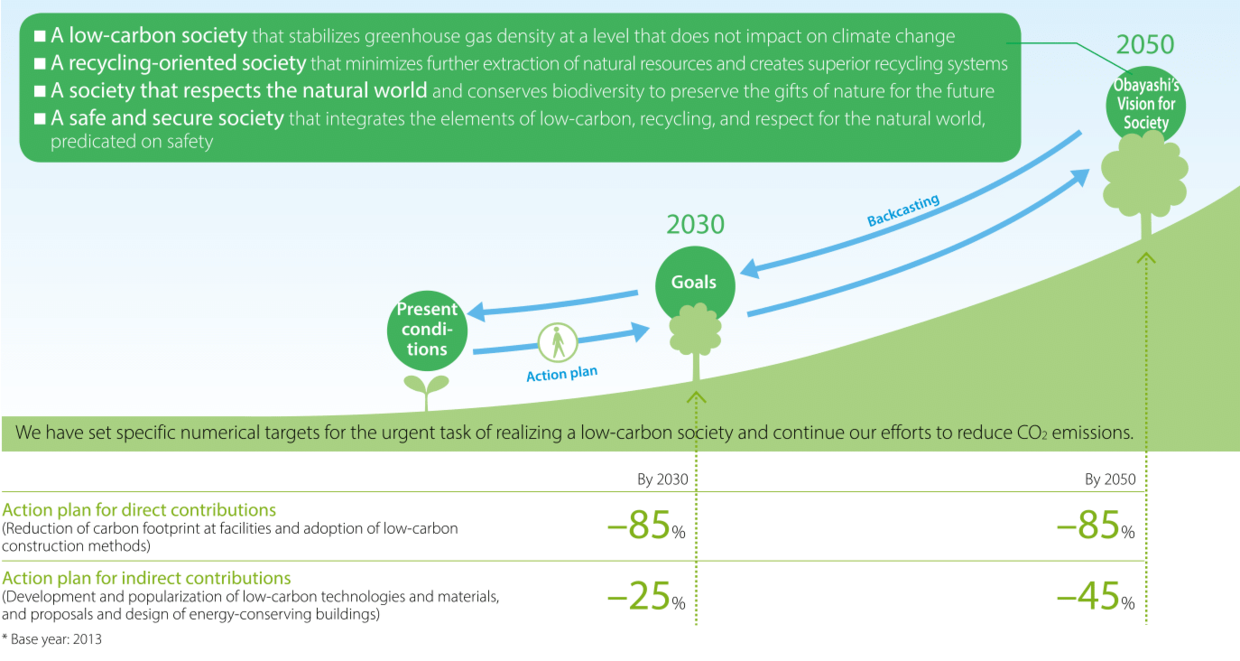
Obayashi Corporation’s CSR
The company holds the belief that its corporate responsibility is to bring smiles to people, making it a goal of all of its business activities. As a good corporate citizen, Obayashi strives to meet the expectations and respond to the needs of all stakeholders, and the four letters of the keyword EGAO (smiles) encapsulate the company’s approach to corporate social responsibility (CSR).
The company utilized this approach in implementing each of its CSR policies. In June 2011, it established and announced the “Obayashi Group CSR Procurement Guidelines” and the “Obayashi Statement on Human Rights.” The CSR Procurement Guidelines were established to enforce CSR across the entire supply chain (all suppliers, including specialist subcontractors, material and product suppliers, and staffing companies) and to advance their activities together. The guidelines set out a framework with nine items to be addressed: “Compliance with Laws and Regulations,” “Establish Corporate Ethics,” “Respect for Human Rights,” “Safety and Health,” “Consideration of Environment,” “Quality,” “Disaster Risk Management Systems,” “Information Security,” and “Social Responsibility.”
In the area of human rights, the company had been focusing on issues with discrimination, harassment, and other matters. However, with the publication of ISO 26000 (international standard for social responsibility) in 2010, the company stipulated the “Obayashi Statement on Human Rights,” recognizing, in line with its overseas operations, the necessity to pay attention to wide-ranging issues, including forced labor and child labor, which were not familiar issues in Japan.
In addition, the “Obayashi Social Responsibility Policy” was established in July 2011. Its aim was to outline the company’s commitments and articulate them clearly for both internal and external stakeholders, in accordance with the company’s intention to “offer solutions to environmental and social challenges and actively engage in social contribution activities to help build a sustainable world” as stated in the Principles. The policy set out the direction for Group companies to engage in social contribution initiatives by bringing together the unique resources of each company, considering in particular “Global Environmental Responsibility”; “Disaster Readiness and Post-Disaster Reconstruction”; “Good Citizenship in Local Communities”; and “Inspiration for the Next Generation” as key priorities.
In August 2013, the company joined the United Nations Global Compact. Obayashi declared it would promote responsible management and contribute to the creation of a sustainable society as a global company by supporting the Compact’s ten principles in the four areas of human rights, labor, the environment, and anti-corruption.
The company expanded its social responsibility activities in October 2014, introducing the Matching Gift Program, in which it matches donations made by executives and employees. Through the program, the company donates to selected recipient organizations that are active in the categories of environment, disaster support, and social initiatives (including local communities and fostering young people).
Great East Japan Earthquake and Contribution to the Recovery Effort
The Great East Japan Earthquake struck on March 11, 2011. Its epicenter was on the ocean floor of the Pacific Ocean off the coast of Miyagi Prefecture, and with a magnitude 9.0, it was the largest earthquake ever recorded by the Japan Meteorological Agency. The earthquake devastated countless houses, facilities, and infrastructure including railways and roads. The tsunami triggered by the earthquake swept along the Pacific coast, spanning a wide area from the Tohoku region in the north to the Kanto region, causing tremendous damage.
As one of Japan’s leading construction companies, Obayashi Corporation sprang into action, providing emergency relief in the earthquake’s immediate aftermath. The company sought to restore production facilities and public infrastructure as quickly as possible, utilizing its strengths as a construction company to procure personnel, supplies, and means of transportation. Support personnel were dispatched to conduct on-site surveys, and strategies were implemented for restoration work to be carried out that met the needs of the affected companies and local governments. The company also supported the livelihoods of the people affected to the greatest extent possible. In addition to procuring supplies, of which there were shortages from all over Japan, including temporary toilets and fuel, and delivering them to evacuation centers, the company built temporary medical facilities to serve as first aid centers. Following this emergency response, the company was involved in the disposal of the large volumes of debris generated as a result of the disaster, as well as decontamination, reducing the volume of waste material in areas contaminated by radiation, and reconstruction work.
In a joint venture (JV) project involving Obayashi, the JV participants took charge of the three towns of Okuma, Naraha, and Hirono, and the village of Kawauchi, all in Fukushima Prefecture, to manage a decontamination model demonstration project implemented by the Japan Atomic Energy Agency at the request of the Cabinet Office. The project was conducted in the restricted zone within a 20-kilometer radius of the Fukushima Daiichi Nuclear Power Station and in 12 municipalities in the planned evacuation zone. The company was also contracted to carry out restoration and reconstruction work, including debris disposal in the Watari district of Miyagi Prefecture (in a JV), and radiation decontamination in the Watari district of Fukushima City (in a JV) and the Tominari district of Hobara Town in the city of Date, both in Fukushima Prefecture.
A partnership agreement was concluded between the municipalities affected by the disaster and the Urban Renaissance Agency (UR). Under this agreement, UR implemented reconstruction projects that integrated urban development in the affected areas. In April 2013, a joint venture led by Obayashi Corporation was commissioned to undertake a reconstruction and community development project in Yamada Town by utilizing the construction management (CM) system. The urban area of this town on the central coast of Iwate Prefecture had been devastated by the tsunami. The company contributed to the swift recovery of this area through integrated management of initial studies, surveying, design, and construction for urban development, which were based on the government’s disaster prevention collective readjustment promotion projects, land reallocation projects, and tsunami reconstruction base maintenance projects.
(Reference: Special Contents > Six Stories > Great East Japan Earthquake)
Quality control of commissioned business related to nuclear power had been mainly undertaken by the Senior General Manager of the Nuclear Facilities Division in accordance with the company-wide Quality Management System (QMS). However, after the Great East Japan Earthquake, Japanese and overseas regulatory agencies as well as electric power companies and other parties began to demand a higher level of quality management. In response, the Quality Assurance Department was established in the Nuclear Energy Division in April 2012 as a specialized department in charge of quality assurance.
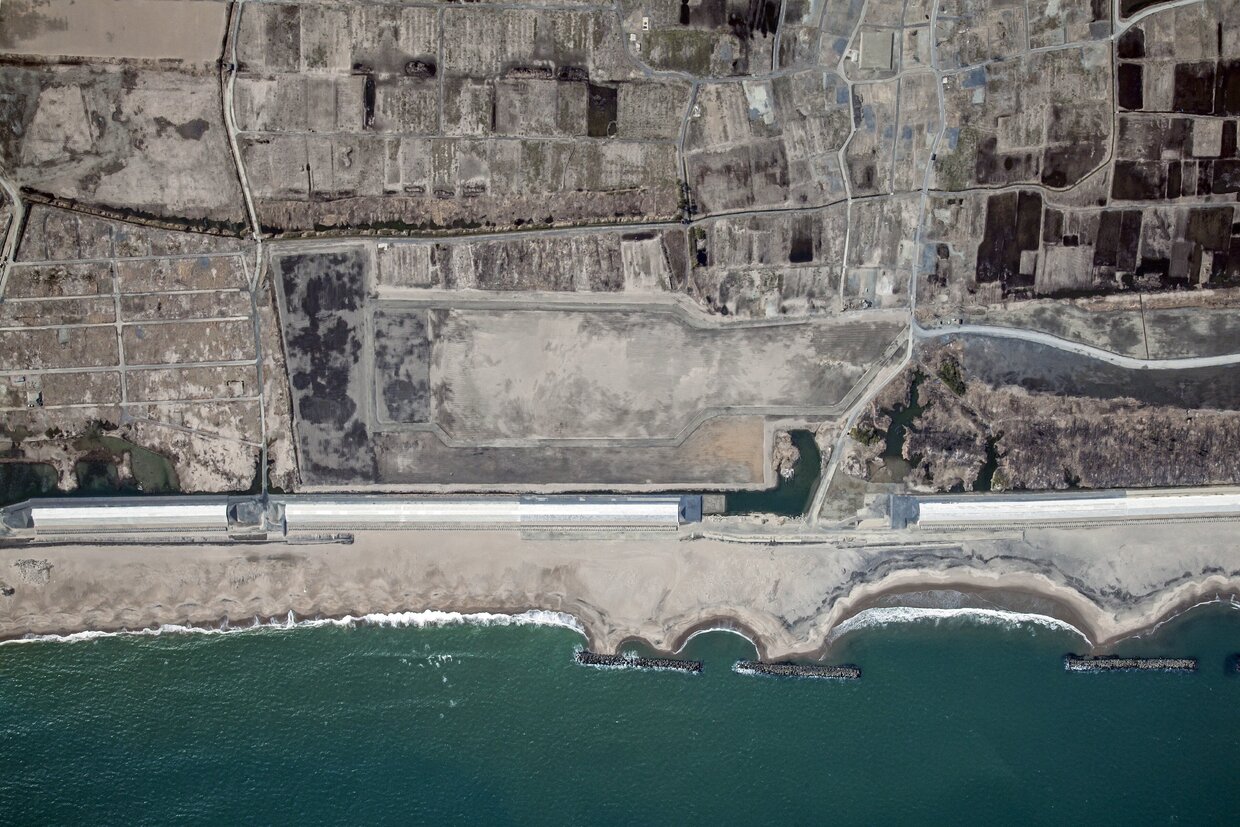
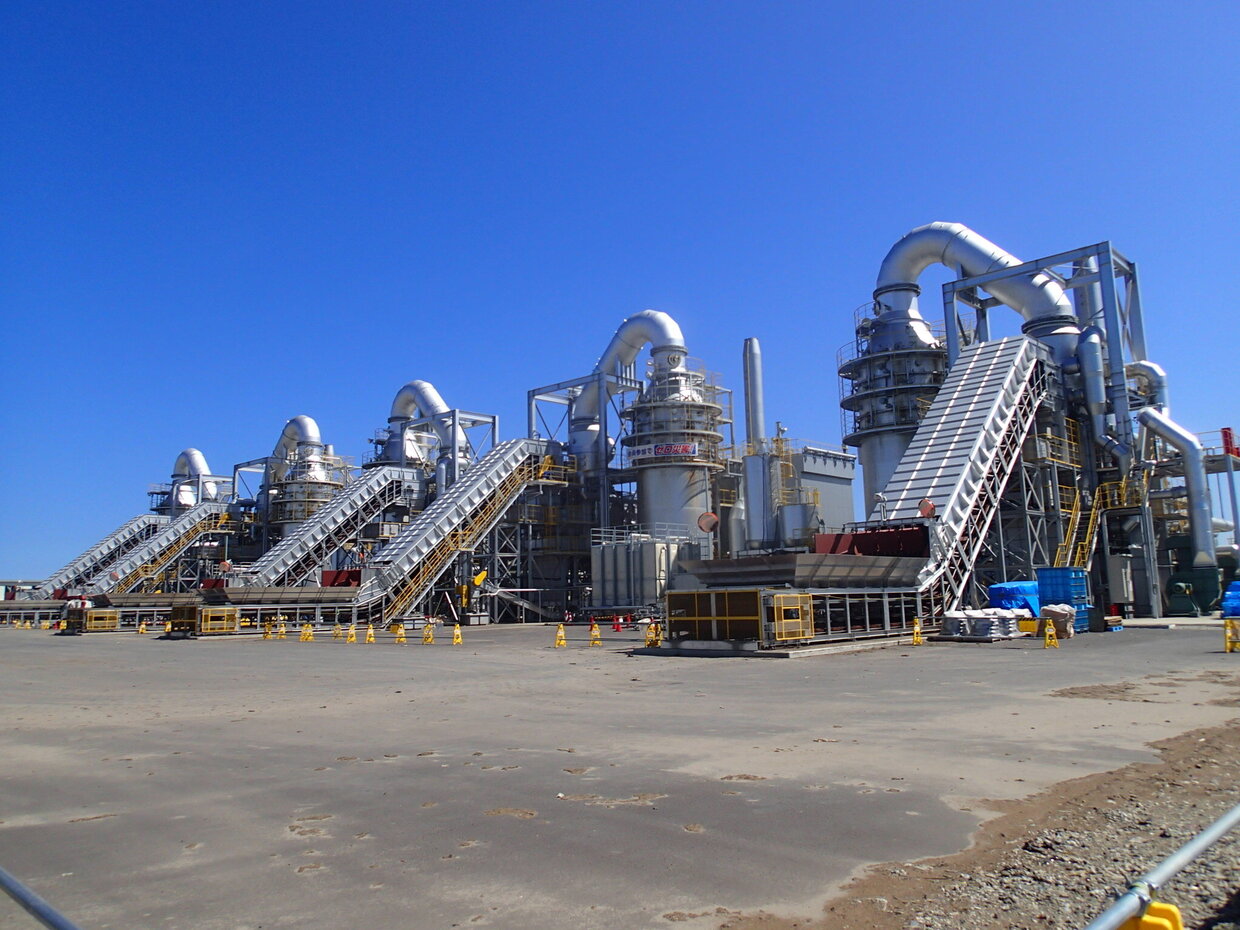
Project for Reconstruction of Fukushima―Kaeru Kawauchi
The tsunami following the Great East Japan Earthquake caused leakage of radioactive material at Tokyo Electric Power Company’s Fukushima Daiichi Nuclear Power Station, forcing many residents in the surrounding areas to evacuate. A decade later, there are still areas designated as “difficult-to-return” zones.
Fukushima suffered catastrophic damage from the earthquake and tsunami. The first step to paving the way for recovery was the disposal of the disaster waste (debris), followed by decontamination. In 2012, the government announced a roadmap for decontamination, and villages in the Special Decontamination Area then formulated a decontamination implementation plan and commenced decontamination. Obayashi Corporation was put in charge of decontamination in the village of Kawauchi, located one village away from Futaba, the town of the nuclear power plant where the accident occurred. Kawauchi boasts abundant and beautiful water resources supplied by the forests of Abukuma Plateau. Hebusunuma, a breeding ground of the forest green tree frog, is designated a national Natural Monument. The residents of Kawauchi have maintained the lush forests and pristine rivers, and the forest green tree frog has been beloved by the residents. Under the slogan “Kaeru Kawauchi,” the people united to end village-wide evacuation and return to Kawauchi. Kaeru Kawauchi is a play on the Japanese word kaeru, which means both “frog” and “return home.”
Shortly after Kawauchi was assigned to Obayashi, construction site staff went to the village government office and asked for permission to adopt “Kaeru Kawauchi” as the name for the local office. This was to serve as a reminder that decontamination will be followed by restoration of Kawauchi that will allow its residents to return to the village as quickly as possible.
Decontamination methods implemented vary according to location and the surface being treated. Roofs and walls of houses were wiped with a damp paper cloth. Rain gutters were cleaned by removing fallen leaves and other debris. Turf was replaced, and gravel and soil were re-laid. Roads, other paved surfaces, and guardrails were cleaned using high-pressure washing. All of this was performed meticulously by hand. The work required persistence but was necessary to restore normal daily life and enable “Kaeru Kawauchi” (return home to Kawauchi).
Whole area decontamination was completed in March 2014, and the evacuation order for Kawauchi was lifted in stages in October 2014 and June 2016. Life has returned to normal little by little. Today, Kawauchi is on the path from reconstruction to new village creation.
